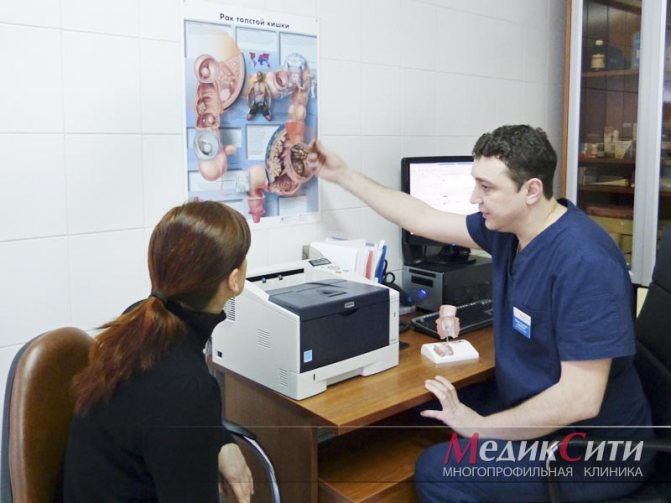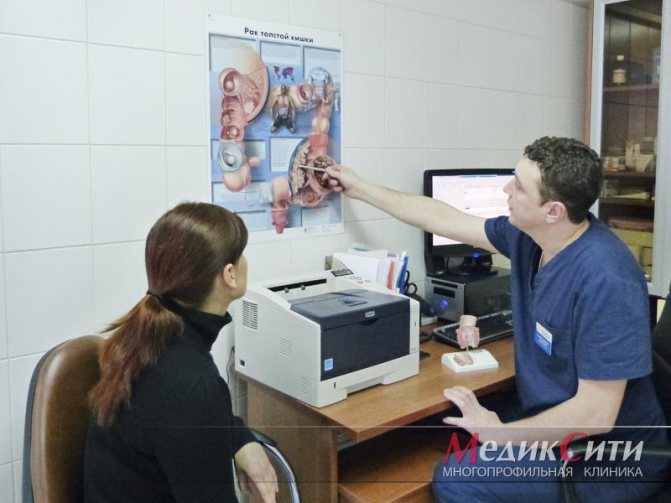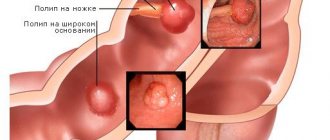What it is
A polyp is a benign neoplasm that affects the surface of the sigmoid colon, located on the left side of the abdominal cavity. It is in this department that the processes of digestion of food and the formation of feces take place.
A polyp of the sigmoid colon is considered a precancerous disease. The neoplasm is formed from fibers of glandular tissue and grows into the intestinal lumen.
In the initial stages of development, symptoms occur in rare cases and often resemble a common intestinal disorder. But over time, the polyp grows, reaches significant sizes and becomes the cause of pain.
If a number of signs of pathology occur, patients are forced to urgently seek medical help.
Prevention and prognosis
Removing various types of polyps is a standard and uncomplicated procedure. However, there is a risk of adverse effects. The main danger of colonoscopy is the development of internal bleeding.
Under certain circumstances, the intestines or other abdominal organs may be injured by the endoscope. Anal surgery occasionally causes sphincter atony. In the case of surgery through the abdominal cavity, disturbances in the healing of wounds of internal organs or the abdominal wall may occur.
Kinds
Depending on a number of features in medicine, there are different types of polyps that affect the mucous membrane of the sigmoid colon.
Some of them do not reach large sizes and manifest a number of symptoms in rare cases. But other types of formations can develop into cancer.
Hyperplastic
They are considered the most common, as they are found in most patients.
Hyperplastic type formations are usually no more than five millimeters and are light in color. In appearance they resemble flat plaques.
Against the background of the dark-colored mucosa, the formations are clearly visible. Over time, they manifest themselves with many symptoms, but despite this, in rare cases they degenerate into cancer. Pathology requires specialist supervision.
Adenomatous
They are the most dangerous type of sigmoid colon polyps, as they are prone to transformation into a malignant course.
They are considered a precancerous condition and require immediate treatment. Depending on the stage of development, formations can reach 1-5 cm.
This species is divided into several types, including villous, tubular and villous-tubular.
In the initial stages of formation they are asymptomatic. But over time, patients experience intestinal obstruction due to the large size of the formation.
In addition, villous polyps are often injured and accompanied by bleeding.
Diffuse
The main cause of occurrence is heredity. The formations are always multiple and are also observed in children and adults.
On this topic
- Digestive system
Differences between sigmoidoscopy and colonoscopy
- Natalya Gennadievna Butsyk
- December 9, 2020
A distinctive feature is rapid development and expansion. In certain cases, the presence of several hundred and even thousands of small neoplasms is observed.
Treatment depends on the type of polyps formed on the surface of the mucous membrane of the sigmoid colon.
Preparation
A few days before removal of polypous formations, the patient provides the doctor with a list of medications that he is taking in order to exclude blood thinning medications, because. they can cause severe bleeding. The main preparatory period begins the day before surgery and requires:
- Drink a large amount of water (3.5 liters) a day to start cleansing the intestines.
- Consume only liquid foods and purees.
- After 6 pm, do not eat anything and take a laxative.
- Before going to bed, do an enema to cleanse the intestines.
Reasons for the development of the disease
Experts have not yet reached a consensus on the reasons for the development of polyps. The following factors are believed to influence and increase the likelihood of their formation:
- Diseases of the large intestine that are chronic. These include colitis, diverticulosis, Crohn's disease.
- Disturbance microflora .
- Improper diet , when a person does not consume enough fiber, which leads to decreased intestinal motility.
- Heredity.
As a result of research, it was found that predominantly male patients are susceptible to the development of the disease. Polyps in the sigmoid colon are observed 4 times less often in women.
Clinical picture
Polyps formed on the surface of the rectal mucosa most often do not show symptoms at the initial stages of their development.
Diagnosis of the disease occurs through instrumental research methods for other diseases.
In the presence of multiple formations, the symptoms are always quite pronounced, but only in cases where the tumor exceeds 3 cm in size.
On this topic
- Digestive system
The role of hormonal contraceptives in the development of liver hemangioma
- Natalya Gennadievna Butsyk
- December 6, 2020
Clinical manifestations of sigmoid colon polyposis are:
- The presence of blood in the stool.
- Painful sensations.
- Itching when changing body position.
- Bleeding from the anus.
- The presence of mucus in the stool.
- Abnormal stool . In this case, diarrhea gives way to constipation.
- Frequent urge to defecate, which is most often false.
- Nausea accompanied by vomiting.
- Gas formation.
In especially severe cases, prolapse of polyps from the anus is noted. Patients also develop fever, in which chills are replaced by fever, weakness and intestinal obstruction.
Polyps of the rectum and colon
Consultation with a proctologist – 50%!
Upon referral from an endoscopist (after colonoscopy), a gastroenterologist or a gynecologist at MedicCity, a consultation with a proctologist.
Resident of the microdistricts "Savelovsky", "Begovoy", "Airport", "Khoroshevsky"
This month, residents of the Savelovsky, Begovoy, Airport, and Khoroshevsky districts.
Second opinion
Not sure if your diagnosis is correct? Doubts away! Come to “MedicCity” and consult with Mr. for free.
Discounts for friends from social networks!
This promotion is for our friends on Facebook, Twitter, VKontakte and Instagram! If you are a friend or subscriber of the clinic’s page &laqu.
Abdullaev Rustam Kazimovich
Coloproctologist, general surgeon
Pak Alexey Gennadievich
Sazonov Viktor Vasilievich
Proctology in “MedicCity”
“MediaMetrics”, radio station, “Online reception” program (February 2017)
“Pharmacy”, magazine for doctors, pharmacists and pharmacists (May 2020)
Rectal polyps are a collective concept that includes benign intestinal neoplasms, both true and inflammatory.
A rectal polyp is a benign tumor consisting of the mucous membranes of the rectum and colon. Most often, the polyp is attached to the wall of a hollow organ using a base or its stem. A rectal polyp grows from epithelial tissue, but inside it consists of other tissue.
The shape of a rectal polyp can be spherical, mushroom-shaped, or branched. The polyp has a soft consistency, pink, dark red or burgundy color (depending on the blood supply to the polyp).
Polyps can appear in any organ of the digestive tract; this disease is quite common. Rectal polyps can be found in people of any age, even children.
In men, this disease occurs one and a half times more often than in the fair sex.
Consultation with a proctologist in MedicCity

Consultation with a proctologist in MedicCity

Consultation with a proctologist in MedicCity
Diagnostic methods
If unpleasant symptoms appear that indicate the presence of polyps in the sigmoid colon, you should contact a gastroenterologist. The specialist will conduct an examination, establish symptoms and study the medical history.
To confirm the preliminary diagnosis, the doctor prescribes a number of diagnostic measures. First of all, the patient needs to submit stool for laboratory testing.
The purpose of the analysis is to identify hidden blood clots. But the complete absence of neoplasms in the sigmoid colon does not guarantee that there are no polyps.
On this topic
- Digestive system
What causes thickening of the intestinal wall
- Natalya Gennadievna Butsyk
- December 3, 2020
Among instrumental diagnostic methods, one of the most informative ways to identify the disease is colonoscopy.
Thanks to the technique, a specialist can examine the large intestine from the inside. The procedure is performed using a special tube called a colonoscope.
Irrigoscopy is also prescribed. Examination of the intestinal walls is carried out using a contrast agent.
Sigmoidoscopy is used to examine the lower intestine. The study is carried out using a flexible tube with an LED at one end.
An accurate diagnosis can only be made based on research results.
Treatment methods
When establishing sigmoid colon polyposis, drug therapy is not used, since drugs are not effective in this case.
Treatment is carried out only by surgery.
Today, the removal of tumors formed on the walls of the sigmoid colon can be carried out using several methods.
Polyectomy
The procedure is performed using an endoscope. An electrode is inserted through the holes made. Then they wrap a special loop around the leg of the polyp, with the help of which the neoplasm is attached to the intestinal walls. After this, a current of high frequency is applied.
The duration of exposure is only a few seconds. This time is enough for the tissue of the neoplasm to begin to die. The polyp is removed using special grab scissors. The bed where the formation was located is cauterized.
The procedure is performed only in cases where the polyp stalk is not very thick. If it is thick enough, coagulation is used. The tumor is cut off gradually.
On this topic
- Digestive system
Irrigoscopy or colonoscopy
- Olga Vladimirovna Khazova
- December 3, 2020
If there is a large formation and a wide base, the operation is performed in stages. There should be 1 to 3 weeks between procedures. This time is enough for the wounds to begin to heal after the intervention.
After the operation, the removed tumor is sent for histological examination to identify the presence of altered cells and confirm or refute cancer.
The operation is well tolerated by patients. After the procedure, there is no need for a rehabilitation period, and the patient can start working within 2-3 days.
Transanal resection
Type 3 polyps can be removed through the anus. The operation is performed using local anesthesia . After it has taken effect, the specialist, using a special mirror, expands the anus, intercepts the formation with a clamp and removes it. The resulting mucosal defect is sutured.
Transanal resection is currently used in exceptional cases, since after the procedure there is a high probability of re-formation of polyps.
Endoscopic method
Endoscopic operations have gained great popularity in medicine over the past few years. They have many advantages.
The procedure is performed using an endoscope equipped with instruments and a camera.
During the operation, it is possible to remove villous, adenomatous, hyperplastic polyps, which are located no further than 20 centimeters from the anus.
Abdominal surgery
The indication for this procedure is the presence of multiple polyps affecting the sigmoid colon. The specialist removes not only the tumors, but also part of the intestine.
The intervention is performed under general anesthesia. The disadvantage of the operation is the long rehabilitation period.
Can polyposis develop into cancer?
Polyps are benign formations. They can form in various organs.
But with abnormal division of tissue cells, neoplasms can transform into cancerous tumors, which is dangerous for the human body. That is why, in the case of diagnosing polyposis of the sigmoid colon or other organs, a thorough examination is required.
Patients should follow a special diet after removal of a sigmoid polyp.
It will help reduce the load on the intestines and prevent the recurrence of the disease.
Indications and contraindications for surgery
Colonoscopy is necessary for the diagnosis of various diseases, early detection and follow-up of colorectal cancer. Here are the most important indications for the use of colonoscopy:
- Lots of blood in stool
- Noticeable changes in bowel habits: diarrhea (diarrhea) or constipation,
- Constant abdominal pain
- If the test is positive for occult blood in the stool (microhematuria), the test should be performed annually to screen for colorectal cancer from age 50 years,
- For early detection of colon cancer, colonoscopy should be performed after 55 years every 2 years,
- If you suspect hereditary diseases that can cause cancer or polyposis,
- After removal of benign tumors.
Possible complications
The main danger of polyps is the likelihood of them turning into cancer. Also among the complications of the disease are:
- Rectal bleeding that occurs when a polyp is injured.
- Acute intestinal obstruction The cause is a large formation that closes the intestinal lumen.
- Enterocolitis . It is a dangerous condition in which the intestinal wall is affected by an inflammatory process. Lack of therapy causes death.
Against the background of regular bleeding, anemia develops over time. That is why, when sigmoid colon polyposis is diagnosed, immediate treatment is required.










